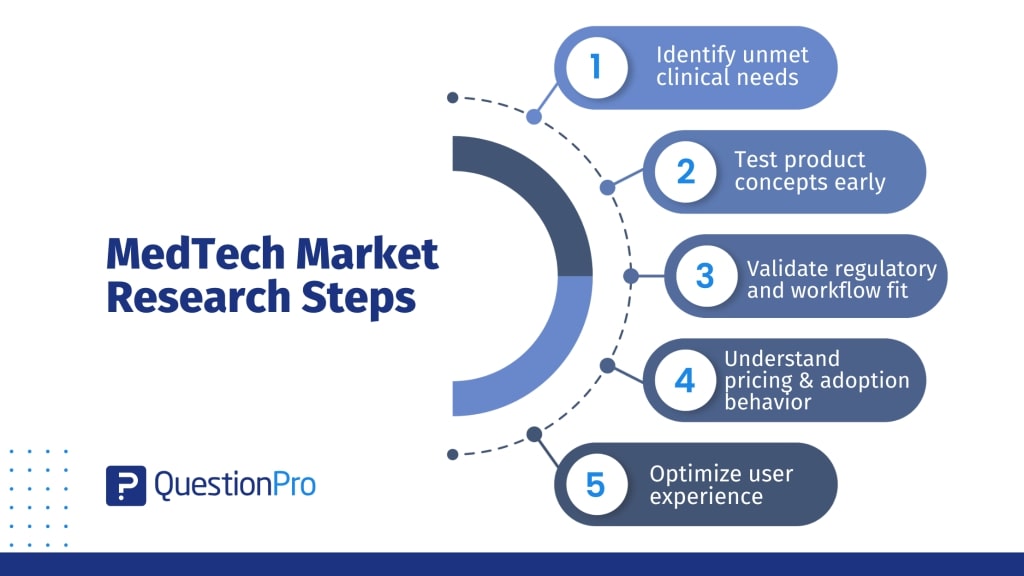
The medtech industry enters 2025 with renewed momentum. After several uneven years of regulatory bottlenecks and investor caution, fresh clinical breakthroughs and strategic investments are breathing new life into the sector.
Heartflow, for instance, is redefining cardiovascular diagnostics with an AI-powered platform now used in 84% of the top 50 U.S. heart hospitals. Meanwhile, Eli Lilly’s orforglipron—an oral GLP-1 receptor agonist—has cleared Phase 3 trials, promising a new oral treatment option for type 2 diabetes without the dietary restrictions typical of injectables.
Investment activity is also heating up. HistoSonics, a developer of sound-wave-based tumor treatment tech, is reportedly exploring a $2.5B+ acquisition with backing and distribution ties from giants like GE HealthCare, Johnson & Johnson, and Medtronic.
With new products, diagnostics, and therapeutics reshaping the field, medtech market research has never been more critical. It’s the difference between a promising prototype and a market-ready solution. From clinical validation to understanding unmet needs and navigating global reimbursement paths, medtech market research anchors product strategy in evidence—not assumptions.
What is MedTech market research?
MedTech market research is the practice of collecting insights specific to the development, launch, and scaling of medical technologies. These technologies range from diagnostic tools and surgical robotics to wearables, software-as-a-medical-device (SaMD), and digital therapeutics.
Research in the healthcare industry requires a deeper level of clinical understanding than general market research, often involving licensed professionals like physicians, radiologists, or pharmacists. It’s not just about usability or appeal—it’s about clinical relevance, safety, and functional alignment with how medicine is actually practiced.
What makes medtech market research unique is its dual burden: it must meet both user expectations and regulatory standards. A promising tool in a lab may fail at the bedside without a thorough investigation into healthcare professionals’ workflows, priorities, and practical pain points. That’s why methodologies like user experience testing, needs mapping, and even ethnographic observation are central to effective research. These techniques help ensure that design, functionality, and messaging all support meaningful use in real-world medical settings.
Skipping or skimming through this research process is often the beginning of the end. According to industry estimates, up to 75% of early-stage medtech companies in the U.S. never succeed. A common pitfall? Failing to plan for market access early. Without validated insight into payer expectations, user adoption barriers, or patient pathways, even highly engineered devices can stall. Medtech firms often invest heavily in R&D but neglect critical questions like: Who will use this? Who pays for it? What problems does it truly solve—and for whom?
Fortunately, not all market research requires an enormous investment upfront. For many early-stage companies, and even larger medtech suppliers, surveys are a practical way to begin. A simple medtech market research workflow might involve:
- Needs assessment: Survey physicians or clinical staff about current workarounds and unmet needs.
- Concept testing: Share a product prototype or idea and gather feedback on perceived value, usability, and concerns.
- Pricing sensitivity: Use conjoint or Van Westendorp analysis to explore willingness to pay or cost-based objections.
- Segmentation surveys: Understand how needs vary by hospital type, geography, or practitioner role.
- UX evaluation: Test software or hardware interfaces using structured questions to guide refinement.
Each step contributes to building a defensible value story—one that pays off in investor meetings, regulatory submissions, and sales cycles. The earlier this insight is gathered, the more agile and aligned product teams can become.
MedTech Market Research Steps
Effective medtech market research follows a structured approach that blends clinical insight, user feedback, and commercial validation. Unlike consumer products, medical technologies must prove their value across multiple dimensions—clinical effectiveness, usability, cost-effectiveness, and regulatory readiness.
These steps help de-risk the product lifecycle, starting as early as concept development. They are especially powerful when paired with surveys, which allow for rapid feedback collection across clinicians, administrators, and even patients. Whether you’re refining a prototype, preparing a regulatory submission, or validating a go-to-market strategy, these core steps provide a repeatable framework.
Below is a simplified, survey-led approach that any medtech team—from startup to enterprise—can implement:

Step #1: Identify unmet clinical needs
Start by surveying your target users—clinicians, technicians, or caregivers—to understand real-world gaps. Ask about current workarounds, frustrations, and clinical inefficiencies. This ensures your solution addresses actual pain points, not assumed ones.
Step #2: Test product concepts early
Use image-based or video-embedded surveys to showcase your prototype or idea. Ask about perceived utility, ease of use, safety concerns, and how it compares to existing options. Concept testing helps prioritize features before you build.
Step #3: Validate regulatory and workflow fit
Run surveys that explore how your product fits within clinical protocols, billing practices, or regional regulations. You’ll uncover hurdles early, such as integration complexity or misalignment with reimbursement codes.
Step #4: Understand pricing and adoption behavior
Explore pricing tolerance using methods like Van Westendorp or Gabor-Granger within your survey. Segment responses by job role (e.g., clinician vs. procurement) to see how different stakeholders assess value.
Step #5: Optimize user experience
Launch usability surveys on your digital interface, handheld device, or workflow steps. Ask about interface clarity, setup time, training burden, and safety perception. This is critical before large-scale rollouts or pilots.
Conclusion
Conducting market research in medtech might sound complex—but it doesn’t have to be. With the right tools and structured approach, even early-stage companies can gather valuable insights that guide product design, validate demand, and avoid costly missteps.
At QuestionPro, we simplify this process. Our survey platform allows you to engage with healthcare professionals, patients, and decision-makers quickly and securely. With built-in compliance for HIPAA, GDPR, and other healthcare data regulations, you can confidently collect sensitive feedback without compromising privacy. And once your data is in, our advanced BI dashboards help you visualize key trends, segment responses, and generate actionable insights.
Whether you’re designing a new diagnostic device, improving a digital therapeutic, or planning a global product launch—QuestionPro gives you the research infrastructure to do it smarter, faster, and with confidence.







